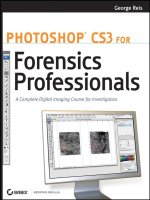3D in Photoshop: The Ultimate Guide for Creative Professionals doc
Bạn đang xem bản rút gọn của tài liệu. Xem và tải ngay bản đầy đủ của tài liệu tại đây (11.64 MB, 225 trang )
Simpo PDF Merge and Split Unregistered Version -
3D in Photoshop
|
Simpo PDF Merge and Split Unregistered Version -
This page intentionally left blank
Simpo PDF Merge and Split Unregistered Version -
3D in Photoshop
The Ultimate Guide for Creative
Professionals
Zorana Gee
Pete Falco
AMSTERDAM BOSTON HEIDELBERG LONDON NEW YORK OXFORD
PARIS SAN DIEGO SAN FRANCISCO SINGAPORE SYDNEY TOKYO
Focal Press is an imprint of Elsevier
|
Simpo PDF Merge and Split Unregistered Version -
Focal Press is an imprint of Elsevier
The Boulevard, Langford Lane, Kidlington, Oxford, OX5 1GB, UK
30 Corporate Drive, Suite 400, Burlington, MA 01803, USA
First published 2010
Copyright Ó 2010 Zorana Gee and Pete Falco. Elsevier Inc. All rights reserved.
The rights of Zorana Gee and Pete Falco to be identified as the authors of this work has been
asserted in accordance with the Copyright, Designs and Patents Act 1988
No part of this publication may be reproduced or transmitted in any form or by any means,
electronic or mechanical, including photocopying, recording, or any information storage
and retrieval system, without permission in writing from the publisher. Details on how to
seek permission, further information about the Publisher's permiss ions policies and our
arrangement with organizations such as the Copyright Clearance Center and the Copyright
Licensing Agency, can be found at our website: www.elsevier.com/permissions
This book and the individual contributions contained in it are protected under copyright by
the Publisher (other than as may be noted herein).
Notices
Knowledge and best practice in this field are constantly changing. As new research
and experience broaden our understanding, changes in research methods, professional
practices, or medical treatment may become necessary.
Practitioners and researchers must always rely on their own experience and knowledge in
evaluating and using any information, methods, compounds, or experiments described
herein. In using such information or methods they should be mindful of their own safety
and the safety of others, including parties for whom they have a professional responsibility.
To the fullest extent of the law, neither the Publisher nor the authors, contributors, or
editors, assume any liability for any injury and/or damage to persons or property as a matter
of products liability, negligence or otherwise, or from any use or operation of any methods,
products, instructions, or ideas contained in the material herein.
British Library Cataloguing in Publication Data
3D in photoshop: the ultimate guide for creative professionals.
1. Adope photoshop. 2. Digital art. 3. Three-dimensional imaging.
I. Gee, Zorana. II. Falco, Pete.
776-dc22
Library of Congress Control Number: 2010930199
ISBN: 978-0-240-81377-6
For information on all Focal Press publications
visit our website at focalpress.com
Printed and bound in the United States
10111210987654321
Simpo PDF Merge and Split Unregistered Version -
Contents
Foreword ix
About the Authors and Acknowledgements xi
Introduction xv
Part I Introduction to 3D Concepts 1
Chapter 1 Scene 3
1.1. The 3D Scene 3
1.2. Meshes and Vertices 3
1.2.1. 3D vs 2D 3
1.3. Cameras 5
1.3.1. Perspective Camera 5
1.3.2. Orthographic Camera 5
1.3.3. Depth of Field 6
1.4. Lights 7
1.4.1. Point Light 7
1.4.2. Infinite Light 8
1.4.3. Spot Light 8
1.4.4. Image-Based Light 9
1.5. Materials 9
1.5.1. Photoshop-Supported Material Properties 11
1.6. UVs 16
1.6.1. UV Maps 17
Chapter 2 Rendering: OpenGL (OGL) and Adobe Ray
Tracer (ART)
19
2.1. OpenGL 19
2.2. Ray Tracing 21
2.2.1. Ray Tracing Effects 22
2.3. Other Render Settings 24
2.3.1. Depth Map preset 24
2.3.2. Normals preset 24
Part II 3D in Photoshop 27
Chapter 3 Getting Started with 3D in Photoshop 29
3.1. Workspace and the 3D Panel 29
3.2. Importing 3D 31
v
Simpo PDF Merge and Split Unregistered Version -
3.3. Converting to 3D 31
3.3.1. 3D Postcard 31
3.3.2. 3D Shape from Preset 32
3.3.3. 3D Repoussé Object 33
3.3.4. 3D Mesh from Grayscale 34
3.3.5. 3D Volumes 35
3.4. Navigating 3D 35
Chapter 4 Materials 37
4.1. Material Library and Browsing Materials 37
4.2. 3D Material Tools and Editing 39
4.2.1. Material Dropper/Loader Tools 39
4.2.2. Changing Material Color 39
4.3. Painting on 3D 40
4.3.1. Optimal Positioning of your 3D Model for Painting 41
4.3.2. Painting on Unwrapped Textures 42
4.3.3. Reparameterizing UVs 43
4.4. Tiled Painting 43
Chapter 5 Lights, Shadows and Final Rendering 45
5.1. Light Types 45
5.2. Positioning Lights and Keyboard Shortcuts 45
5.3. Editing Lights 46
5.4. Adding and Editing Shadows 47
5.4.1. Ground Shadows and Snapping Object to Ground Plane 50
5.5. Colored Transparent Shadows 51
5.6. Final Rendering 55
5.6.1. Test Rendering 56
Chapter 6 Adobe Repoussé e 3D Extrusions 57
6.1. Introduction to Adobe Repoussé 57
6.2. Changing the Repoussé Shape 60
6.2.1. Presets 60
6.3. Constraints 64
6.3.1. Holes 65
6.3.2. Active Constraints 66
6.3.3. Inactive Constraints 66
6.4. Assigning Materials 67
6.4.1. Extrusion Texture Mapping 67
Contents
vi
Simpo PDF Merge and Split Unregistered Version -
6.5. Mesh Quality 67
6.5.1. Repoussé Speed 68
6.6. Split Apart Functionality 68
Chapter 7 Performance Settings and Optimization 71
7.1. 3D Preferences 71
7.2. GPU Memory (VRAM) 72
7.3. Interactive Rendering 73
7.3.1. OpenGL (on by default) 73
7.3.2. Allow Direct To Screen (on by default) 73
7.3.3. Auto-Hide Layers (on by default) 73
7.3.4. Ray Tracer (off by default) 73
7.4. Ray Trace Quality Threshold 73
7.5. 3D File Loading 74
7.5.1. Active Light Source Limit 74
Part III Workflows 75
Chapter 8 3D and Compositing with Bert Monroy 77
8.1. Simple Complexity 97
Chapter 9 Adobe Repoussé with Corey Barker 103
9.1. Text and Reflections 104
9.2. Creating Realistic 3D Product Shots 113
9.3. Masking 3D Shapes for Effect 125
9.4. 3D and Photoshop Effects 133
9.5. Cover Art Breakdown 144
9.5.1. Getting Started 144
Chapter 10 Painting, Texturing and Lighting
with Stephen Burns
153
10.1. Importing 3D Using 3DVIA 154
10.2. Creating the Layout 157
10.3. Texturing the Walls of the Buildings 170
10.4. Lighting the 3D model 173
10.5. Adding the Wet Look to the Street 175
10.6. Adding Localized Bump and Reflective
Characteristics
178
10.7. Adding Depth of Field and the Splash 181
Contents
vii
Simpo PDF Merge and Split Unregistered Version -
Chapter 11 Creating Lenticulars with Russell Brown 187
11.1. Getting Started 188
11.1.1. Equipment and Software 188
11.2. Basic Lenticular Workflow 188
Part IV Appendices 193
Appendix A: File Formats 195
Appendix B: Interoperability and Limitations 199
Index 201
Contents
viii
Simpo PDF Merge and Split Unregistered Version -
Foreword
Gavin Miller
Traditional analog photography combined the creative use of cameras with
post processing in the darkroom. Photographers adjusted scene composition
and lighting, and controlled exposure, focal length and depth of field to
capture the moment on film. In the darkroom, chemical manipulation for
transfer curves was combined with optical manipulations such as dodge and
burn, convolutions using moving film (such as a Rostrum Camera) and
compositing using optical masks.
Photoshop, in its early days, was largely inspired by the desire to move image
manipulations to the digital realm in which they were more repeatable,
convenient and expressive, allowing not dozens but hundreds of layers, and
image transformations and effects not possible with analog processing. At
the same time, Photoshop became a rich graphic design medium in which
vector or raster graphics could be manipulated to create the impression of
some simple forms of lighting and geometry, such as floating text with drop
shadows and embossing.
With the growth of 3D functionality in Photoshop, the creative potential is
expanding in a new direction, in which it is the photographic studio itself that
becomes virtual, with lights, cameras and models taking the form of algo-
rithms rather than physical objects. Many of the same creative decisions
remain from physical photography such as scene composition and camera
focal length and depth of field. But there are a range of new artistic decisions
to make in which the models themselves can be made of a wide variety of
shapes and materials. Images take on a new role as surface textures applied
to geometry, capturing the appearance and structure of substances rather
than whole objects.
A 3D rendering might be an end in itself, or be part of a larger compo-
sition with captured imagery or 2D graphic elements. By integrating 2D
and 3D tools into the same application, a new creative medium is possible
in which layer effects and 3D rendering styles interact to produce images
that would be expensive or impossible to make with either alone. 3D
graphics imposes a certain amount of structure on the resulting images,
with shadows con sistent with the geometry and lighting. Sometimes
a designer will have a particular look in mind and carefully manipulate all
the elements to produce the desired result, but just as valid is exploring
the model by moving the camera and lights around until a happy accident
of light and shadow resonate with the viewer, as happens with physical
photography.
|
ix
Simpo PDF Merge and Split Unregistered Version -
3D graphics has been seen in the past as difficult and expensive for a number
of reasons. Firstly, the computational power required for high-quality image-
making has only recently become main stream. Secondly, the creation of
suitable 3D models is a large undertaking. Finally, there is a steep learning
curve to high-end 3D production tools. The problem of model creation is
being tackled in two ways. For many objects, models now exist in large
libraries on the web, and using them for a particular purpose then becomes
a matter of designing the textures and lighting for a given shot – something
at which Photoshop excels. Secondly, Photoshop CS5 now has a new
modeling tool called Repoussé that focuses on transforming 2D graphic
designs, including text, into high-quality 3D models. While this does not
solve the general modeling problem, it does make accessible the creation of
graphic designs with embedded 3D elements that rival high-end packages.
Combined with imported models and 2D visual elements, highly professional
images are possible with a reasonable amount of work.
For photographers interested in learning how their real-world skills might
extend to graphic design, or for graphic designers keen to grow their 2D
talents into a world of depth and light, this book should serve as a good
introduction. Early chapters focus on the elements of 3D image-making and
how to control them in Photoshop CS5. Later chapters introduce model
creation using Repoussé, and then take on the form of tutorials in which
experts in the field explore how to combine the best features of 2D and 3D
graphics. After that, the readers should be well position to explore the
creative potential of this new tool.
|
Foreword
x
Simpo PDF Merge and Split Unregistered Version -
About the Authors and
Acknowledgements
This book was a collective effort by the Adobe Photoshop 3D Team along
with the Department of Procedural Imaging in Adobe's Advanced Technolo-
gies Lab and, of course, our amazing 3D designers and artists – Bert Monroy,
Corey Barker, Russell Brown and Stephen Burns.
Listed below are the authors and contributors from the Photoshop 3D Team:
Zorana Gee is a Photoshop Product Manager
and has been on the team for over 10 years.
She has been involved with Photoshop
Extended from the beginning and is instru-
mental in the 3D effort. Zorana holds an MBA
from SCU Leavey School of Business. She
speaks world-wide on Photoshop and
Extended and has a deep understanding of the
whole product.
Pete Falco is our Lead Photoshop 3D Engineer
and a contributing author. He is also the co-
editor of this book. Pete received his Masters in
Engineering from Rensselaer Polytechnic
Institute and has over 15 years of experience in
the fields of 3D and image processing. He has
been on the Photoshop team for 5 years and
prior to that was an engineer on QuickTime VR,
RealSpace, and Live Picture, and was a co-
founder of Zoomify.
|
xi
Simpo PDF Merge and Split Unregistered Version -
Daniel Presedo is a Photoshop 3D Quality
Engineer as well as the primary artist for many
of the images in Parts I and II of this book. He
has worked professionally in the illustration
and desktop publishing fields since 1992. With
his unique skill set and proficiency in many 3D
applications from Poser to 3D Max, he helps to
influence how Photoshop 3D features are
delivered.
Nikolai Svakhine is a computer scientist on
the Photoshop team and a contributing author
to this book. With M.S. from Moscow State
University (1999) and Ph.D. from Purdue
University (2007), he joined Adobe Systems in
early 2007. His expertise includes OpenGL
advanced surface and volume rendering,
stereo/lenticular rendering and distributed
network rendering.
Mark Maguire is a Photoshop 3D Engineer and
a contributing author. Mark received his B achelors
in Computer Science from the University of
Massachusetts a t Amherst and has been in the 3D,
video and gaming field for 16 years. He has been
on the Photoshop team for 5 years a t Adobe and
also worked on the LiveMotion team. Prior to
Adobe, he worked on a video e diting software
and award-winning children's games.
In addition, we had two contributing authors from Adobe's Advanced
Technologies Lab:
Pushkar Joshi is a researcher in the Advanced
Technology Labs at Adobe and is one of the
developers of the Repouss
e modeling system in
Photoshop. His research interests include
geometric modeling, intuitive interfaces for 2D
and 3D design, animation, and information
visualization. He studied variational shape
design for his Ph.D. under Carlo Sequin at U.C.
Berkeley. Prior to Adobe, he held research
internships at Pixar Animation studios and the
Institute for Creative Technologies.
|
About the Authors and Acknowledgements
xii
Simpo PDF Merge and Split Unregistered Version -
Aravind Krishnaswamy is a researcher in the
Advanced Technology Labs at Adobe and is
one of the developers of the Ray Tracer in
Photoshop. His current research interests
include the simulation and visualization of
light interaction with matter. The results of his
research on the interaction of light with
human skin have been presented to the
community in various publications and tuto-
rials (SIBGRAPI, Eurographics, AFRIGRAPH and
SIGGRAPH Asia). He recently co-authored
a book titled Light and Skin Interactions –
Simulations for Graphics Applications.
A special thanks goes out to Gavin Miller, Fellow Scientist, and Nathan Carr,
Senior Computer Scientist, who are the primary developers, along with
Aravind, for the Adobe Ray Tracer (ART).
I also want to thank Domnita Petri for being an awesome and thorough 3D
Quality Engineer – always keeping the quality bar high and Tai Luxon for
stepping in and helping as technical editor.
The following artists and designers wrote the workflow chapters in the book:
Bert Monroy is considered one of the pioneers
of digital art. His work has been seen in many
magazines and scores of books. He has served
on the faculty of many well-known institutions,
lectured around the world, written many
books and appeared on hundreds of TV shows.
Bert hosts a weekly podcast called Pixel Perfect
for Revision3.com. He co-authored The Official
Adobe Photoshop Handbook, the first book on
Photoshop, plus many other books since. His
latest book, Photoshop Studio with Bert Monroy:
Digital Painting, has received critical acclaim around the world. Bert writes
a column for Photoshop User and Layers magazines.
Corey Barker is a content developer for Kelby
Media Group and Executive Producer of the
popular tutorial site Planet Photoshop. He is
also co-host of the hit podcast Layers TV and
makes occasional appearances on Photoshop
User TV. Corey is also the co-author of the
recent Photoshop CS4 Down & Dirty Tricks book
and a featured instructor for the Down & Dirty
Tricks seminar tour. Corey has also taught at
events like Photoshop World and Adobe MAX.
About the Authors and Acknowledgements
|
xiii
Simpo PDF Merge and Split Unregistered Version -
Stephen Burns has been a corporate
instructor and lecturer in the application of
digital art and design for the past 10 years. He
has been exhibiting digital fine art interna-
tionally at galleries such as Durban Art
Museum in South Africa, Citizens Gallery in
Yokahama, Japan, and CECUT Museum Of
Mexico to name a few. Part of his exhibiting
won him 1st place in the prestigious Seybold
International digital arts contest. He also
teaches Digital Manipulation workshops in
San Diego and is the author of several books
published by Charles River media.
Russell Preston Brown is the Senior Creative
Director at Adobe Systems Incorporated as
well as an Emmy award-winning instructor. His
ability to bring together the world of design
and software development is a perfect match
for Adobe products. In Russell's 24 years of
creative experience at Adobe, he has contrib-
uted to the evolution of Adobe Photoshop
with feature enhancements, advanced scripts,
and, most recently, Flash panel development.
|
About the Authors and Acknowledgements
xiv
Simpo PDF Merge and Split Unregistered Version -
Introduction
This book is the first of its kind that covers all things 3D in Photoshop CS5
Extended. It is written by the Adobe Photoshop 3D team themselves as well
as respected Photoshop industry leaders and educators. The book has two
overall objectives – to provide the ultimate reference guide for any creative
professional new to 3D as well as to provide creative and inspiring tutorials
that will walk you through the how-to of working with 3D in Photoshop CS5
Extended.
Part I covers general 3D concepts that are important to understand before
experimenting and designing with 3D. Part II covers how 3D works in
Photoshop CS5 Extended, including many of the useful features and
workflows important for any creative professional. Part III inspires us with
awesome 3D tutorials by known Photoshop educators and designers. Part IV
covers important file format information as well as information about
interoperability.
I hope this book will entice all designers to explore the benefits and awe that
3D can bring into their designs and, most importantly, learn something new
while having fun!
|
xv
Simpo PDF Merge and Split Unregistered Version -
This page intentionally left blank
Simpo PDF Merge and Split Unregistered Version -
PART I
Introduction
to 3D
Concepts
Chapter 1 Scene 3
Chapter 2 Rendering: OpenGL (OGL) and Adobe Ray Tracer (ART) 19
In this part
This book is all about Photoshop and the ways you can integrate 3D into your
design workflows; however we wanted to take a step back and start off with
an introduction to basic 3D concepts that will be important to understand,
before diving into how it all works in Photoshop. In this part we explain 3D
concepts in a way that anyone new coming into the world of 3D can
understand so that they can have a solid framework to begin exploring.
Further, those of you that are already familiar with 3D can learn about the
different techniques that we use and how these can add to or optimize your
existing workflows.
1
Simpo PDF Merge and Split Unregistered Version -
This page intentionally left blank
Simpo PDF Merge and Split Unregistered Version -
Scene
1.1. The 3D Scene
A t ypical 3D scene has s everal elements which generate a scene when combined.
You can think of setting up a 3D scene in the same w ay you would set up
a p hotography studio (image above). F irst, you will need some thing to take
a p icture of (your meshes). Second, these meshes will have materials on them
such as wood, cotton, or metal. Third, youneedtoprovidelightingtothescene
with one or more lights. And finally, you need a camera to take the picture with
(rendering). The term rendering is the act of taking a picture of your scene through
your virtual camera using the lighting, material and meshes you have set up.
1.2. Meshes and Vertices
1.2.1. 3D vs 2D
So, what exactly is 3D? You may recall from doing graphing in high school
algebra. You would have two values (x and y) and then find their positions
along the x and y axis of a graph and then use these positions to plot a point.
If you made three of these points and connected them, you would have
a triangle. If you extend this by adding a third axis (z), you can plot points
anywhere in three-dimensional space to create 3D shapes (Figure 1.1).
CHAPTER 1
|
3D in Photoshop. DOI: 10.1016/B978-0-240-81377-6.10001-8
Copyright Ó 2010 Elsevier Inc. All rights of reproduction, in any form reserved.
3
Simpo PDF Merge and Split Unregistered Version -
Objects in a 3D scene are described as collections of 3D points, which are
called vertices. These vertices are collected into groups of three, which form
triangles. These triangles are contained in groups called meshes. Prior to the
time that these triangles are actually drawn, meshes can be described in
many different ways. For example, the equation for a sphere represents a 3D
object. However, if it is to be drawn, it must first be broken down into an
approximation of this shape using triangles (Figure 1.2).
FIG 1.1 A triangle consists of three points on two dimensions (x and y). Extending this to a third axis (z axis)
results in a triangle in 3D.
FIG 1.2 A sphere represented by triangles, used to define meshes.
|
3D in Photoshop
4
Simpo PDF Merge and Split Unregistered Version -
1.3. Cameras
There are two types of camera supported by Photoshop e orthographic and
perspective. Both kinds of cameras have a location, or where the camera is
located in 3D coordinates, and a direction that it is pointed.
1.3.1. Perspective Camera
A perspective camera behaves like a “real world” camera. Perspective
cameras also have a lens, which has a “zoom” that can be represented as
a field of view in degrees or a focal length in mm. This kind of lens will have
perspective distortions as you increase or decrease the field of view.
1.3.2. Orthographic Camera
An orthographic camera is mostly used in engineering and architecture e as
well as in the 3D modeling process. This type of camera has no perspective
distortion which means that when moved, the object of interest does not
change size or shape. This can be very useful when you are trying to align
things in 3D space. Orthographic cameras have a scale, which represents the
size of the slice it cuts through the 3D space. One thing of note here is that
with an orthographic camera, moving an object further from or closer to
the camera (or moving the camera) results in no change to the rendering
whereas with a perspective camera, this will change the way things look
dramatically (Figure 1.3).
FIG 1.3 The top row shows a perspective camera where the car in the middle that is closer to the camera appears to be larger than the car that is farther
away from the camera. The bottom row shows an orthographic camera where both cars regardless of distance from the camera, appear to be the same size.
Scene
|
5
Simpo PDF Merge and Split Unregistered Version -
1.3.3. Depth of Field
In addition to the position and direction of the camera, Photoshop CS5 can
also simulate the aperture of the camera. This is done using the depth of field
settings. With these, you specify the part of your scene that is in focus and
that which is not e in much the same way you focus a lens on a subject when
taking a photograph (Figure 1.4a).
In Photoshop CS5, cameras have a pair of new parameters that allow an
artist to control depth of field. The Distance control determines the plane
in the scene where everything is in focus and the Blur control determines
how out of focus the areas behind and in front of the focus plane are
(Figure 1.4b).
FIG 1.4a Depth of Field set so that the front of the truck is in focus (the plane of focus) and everything else in front of or behind this plane is out of focus.
FIG 1.4b With the Camera Zoom Tool selected, you can set the distance of the focal plane and the amount of blur.
|
3D in Photoshop
6
Simpo PDF Merge and Split Unregistered Version -
1.4. Lights
Visual perception is our perception of how light interacts with matter.
Therefore lighting is a key component of a 3D scene, similar to the import-
ance of lighting in photography. Generally, light interaction with an object is
a very complicated process. Though the primary intent for 3D rendering is to
reproduce the light interaction with materials, steps are taken to simplify and
approximate these calculations. One such step is to limit the supported types
of light sources.
In Photoshop CS5, four types of light sources are supported. The first three
are standard lights that can be found, in one form or another, within any 3D
rendering package (point, infinite and spot lights).
1.4.1. Point Light
In some applications, this also may be known as an “omni ” light. A point light
is a light source emitting light equally in all directions. You can think of this
like a candle or a light bulb. These types of lights have position, but do not
have a direction (Figure 1.5).
FIG 1.5 A point of light depicted by a spherical widget.
Scene
|
7
Simpo PDF Merge and Split Unregistered Version -
1.4.2. Infinite Light
In some applications, this also may be known as a “directional” light. An
infinite light is a light source emitting light parallel to a certain direction. This
is useful for simulating light sources that are very far away (e.g., sunlight).
These types of lights have direction, but do not have a defined position
(Figure 1.6).
1.4.3. Spot Light
Spot lights are similar to photographic spotlights or automobile headlights.
These lights have defined positions, direction, and a hotspot angle
(Figure 1.7).
FIG 1.6 An infinite light source depicted by the yellow widget with an arrow pointing in the direction of the light source.
|
3D in Photoshop
8
Simpo PDF Merge and Split Unregistered Version -









